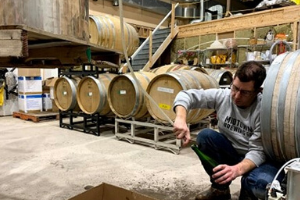“Ask Ryan” features Ryan Monkman of FieldBird Cider, Ontario Canada answering questions from Cider Chat listeners. Ryan expertise with oak barrel ferments and oak barrels in general inspired this 4 part series. The fact that he also makes mighty fine cider and perry is also a factor.

Ryan has been featured in the following Cider Chat episodes:
132: Barrels & Bâtonnage
168: Barrel Aging Cider Inspiration
218: FieldBird Cider | Canada Covid Time Update
In this segment Ryan answers the following questions from Cider Chat listener: Michael
- Is there a general aging graph for size and barrel Barrel Char to achieving a standard level of Tannins and oak flavor? I’m assuming that your answer will probably be no due to so many variables wood, level of char if any, temperatures, rankings etc.
Ryan discusses the difference between French Oak vs American Oak
- French Oak barrels which provide more tannin and less aromatic vs American oak with more aromatic and flavor but less tannin
- The way a barrel is charred
- The more toasted – the less tannin vs less toasted more tannin
The FieldBird Cider Barrel program manages the wide range of flavor profiles in oak by having a Large Barrel program that provides a mix of barrel types.
What to look for in a barrel
- Size – look at surface area ratios
- How much of the cider is touching the barrel at any point.
- The more touching the more flavor you will get from the barrel
2 standard sizes of barrels
- Burgundian barrels – 228 liter / 60 gallons
- Bordeaux – skinny and longer hold 225 liters – just under 60 gallons. These barrels provide more cider in contact with wood.
The higher the % of cider touching the barrel – the quicker you are going to extract.
Oak Tannin is called – sacrificial tannin and it happens to bind with proteins, whereas the tannin in Apples are much slower to react.
Recommend temperature for barrel aging?
Ryan breaks it down into 3 stages to consider.
1 Primary Fermentation
2. Secondary or Malolactic Fermentation
3. Tertiary
What to consider for each stage:
- Depends on what stage you are at during the cidermaking process and what you are trying to say with your cider
- Where will the barrel be stored
- A cooler ferment: 14-16 celsius – rich flora, pretty aromatic, but won’t have a lot of body
- At 20-23 celsius – 70-75 F – more body less aromatic
Note: Yeast produces alcohol and it also produces heat. It is hard to cool down a barrel.
Ferment at a cooler temperature until fermentation is over.
MLF- convert the acid in the apples into Lactic acid which provides a creamy bitterness – you need about 70 F. If cooler it will take a really long time. This long time leaves your cider at risk for bacteria.
3. Tertiary or aging from 3days to 3 years
Store at 65 Farhenheit is ideal, but takes a long time to extract
FieldBird uses a Submersible Aquarium heater
- Make sure it is a fully immersible heater.
- Have a couple different sizes.
In the next episode 222: Ask Ryan – he will answer:
2. Do you see a large difference in profiles when stacking barrels on racks of the same batch of cider due to temperature changes from say a rack of barrels 3-4 high. And Barrel cleaning
Mentions in this chat
Help Support Cider Chat Please donate today. Help keep the chat thriving!
Find this episode and all episodes at the page for Cider Chat’s podcasts.
- Listen also at iTunes, Google Play, Stitcher (for Android), iHeartRadio , Spotify and wherever you love to listen to podcasts.
- Follow on Cider Chat’s blog, social media and podcast
- Twitter @ciderchat
- Instagram: @ciderchatciderville
- Cider Chat FaceBook Page
- Cider Chat YouTube
Haven’t downloaded this episode yet? Here it is again for your listening pleasure.



